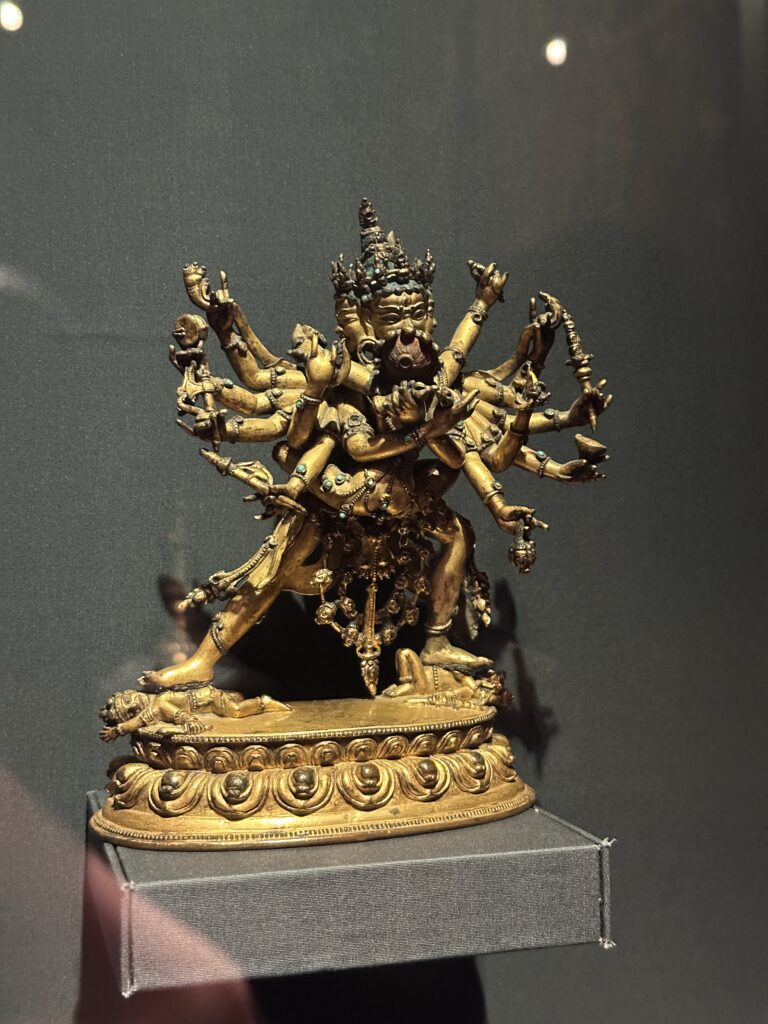Blogging in 2005 and Now
Blogging was most popular in 2005—the year I was born. I, however, believe that twenty years later, there’s a renewed necessity for people to vent in a public diary. I truly don’t view myself as a good writer yet; it’s a muscle I’ve let atrophy. My ego and cynicism will shine through these first few takes. That’s just the truth.
Dark Art and Its Toll

Let’s talk about dark art—and the effect it has on the artist during its conception.
A Recent Painting: Chakrasamvara and Vajravarahi
I went to the Metropolitan Museum of Art, an incredible assortment of human triumphs and tragedies. While there, I stumbled upon a little bronze statue. It stared at me.
In museums, I’ll often align myself with pieces of art that move me. I’ll stand in symmetry with them and exist in their presence. Usually, this ritual is powerful. I take in its message and the weight of its cultural importance gives me strength.
This time, though, the relic made me feel like I was going to fall over. Chills crawled up and down my back as I processed the form. It towered over me despite being the size of my palm.
A male figure stood upon two lesser bodies while hoisting a nude female—shiny bronze, carved in the 1400s. Its peacock arrangement of arms lured me in. I felt like I was facing judgment from an ancient god that had been defamed. I’ve always been suspicious that the gods of old wouldn’t take kindly to our new silicon-veined idol.
Now I needed its forgiveness. I had to tell its message.
Tech as a Third Parent
I have an intense skepticism toward technology. And no, I’m not just a nostalgic luddite who wants to be a 90s teen.
Technology was like a third parent to me. Or a bad-influence cousin. I was raised with it. I watched it grow alongside me. I had fun in the digital worlds of my youth, spent summer weeks tiring my thumb scrolling.
There are good and bad aspects to tech as an advancement. But during my dance with that deity, I learned something darker—the encroaching force of techno-capital is beginning to erode the very fabric of the religions and traditions that shape our species, culturally and physically.
The Painting Process
I spent days pushing and pulling dull yellows. Sometimes fatigue would grip me. Some sections demanded more ferocity.
Each day spent on this piece painted progressively darker circles under my eyes. I started to see the world as I was painting it—corrupt, degrading, sick. And it made me sick.
Just after completing the image, I fell into a week-long, feverish illness—one of the worst sicknesses I’ve experienced in my life.
If I were trying to entertain, I’d say the ancient figure cursed me to bear its message and I got sick from the weight. But I’m a material rationalist at my core. This piece—and its subject—represent deeply embedded webs of meaning, history, pain. Contexts that are painful to look at.
I painted the world exactly how I saw it, in all its sickness and darkness—and I was left feeling dark and sick. No surprises.
Cultural Distance and Real-World Feedback
I did feel concerned that I might not have a place in artistically portraying a figure so far from my culture and background. I found the form in the Asia Wing of the Met, after all. I’m not Asian. I have no formal connection to Tibetan Buddhism.
Still, I decided to let society decide my fate—and not by asking Reddit or TikTok if they think drawing a Buddhist figure covered in wires is cultural appropriation or whatever.
I wanted real-world feedback.
So, on the first 70-degree day of the spring in NYC, I took the piece to a very busy Washington Square Park.
I probably interacted with 100 people that day. About 50% of them were Indian tourists—and they had nothing but kind things to say about the piece. They weren’t just flattered that a Westerner was taking the time to depict a figure from their myths—they were also genuinely interested in the tech symbolism.
Many struck up enthusiastic conversations about the work.
A Message to Artists
If I had to leave you with something, it would be this:
Listen to your intuition when it comes to making powerful pieces.
Even if the piece chews off a part of your soul in the process—see it through.
That said, I won’t be painting the world exactly as I see it for a while.
Instead, I’ll paint the world the way I want it to be.
